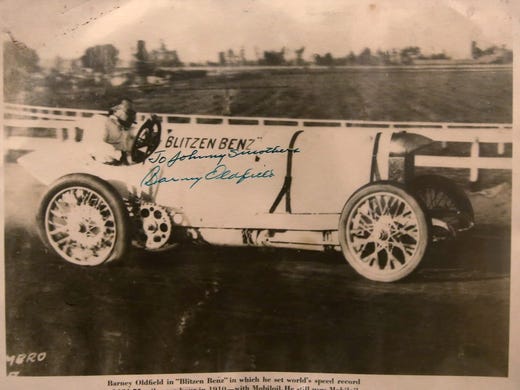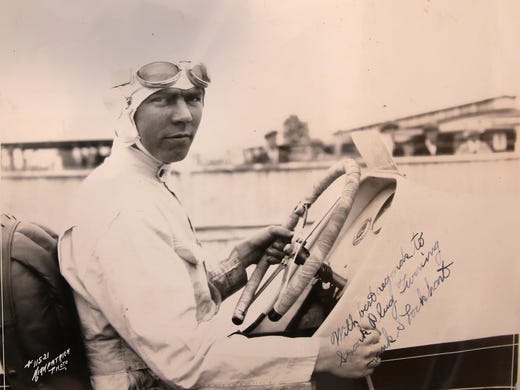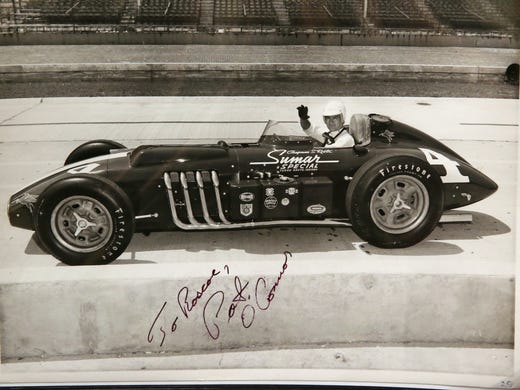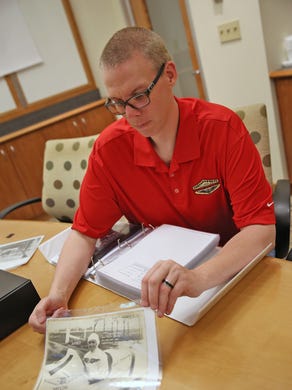They Call Him 'El Maestro' for a Reason
article courtesy of Grandprixhistory.org, with excerpts from Erik Shilling of Jalopnik,
edited by James Karthauser
Stories about Juan Manuel Fangio, the one of the greatest Formula One drivers ever, are pretty well-trod at this point—there’s the famous 1957 German Grand Prix win, the fact that he was in his forties in his prime, the fact that he won 24 of the 51 grands prix he competed in. Less talked about is just how terrifying those races were.
 Affectionately known as "bandy legs" by his many fans, Juan Manuel Fangio was born in Balcarce, Argentina the son of an Italian immigrant in 1911. After military service he opened his own garage and would race in local events. These "local" events were not the weekend meetings that occur all over England but long-distance races held over mostly dirt roads up and down South America. Fangio's first race at eighteen was in a Ford taxi. One particular race, which he won in 1940, the Gran Premio del Norte was almost 10,000 kilometres long. This race between Buenos Aires, up through the Andes to Lima, Peru and back again took nearly two weeks with stages held each day. No mechanics were allowed and any repairs would have to be completed by either the driver or co-driver at the end of each stage. Following many successes driving all makes of American modified stock cars; Fangio was sponsored by the government and sent to Europe to continue his career after the end of World War II. It was not until 1949 at the age of 37 that he achieved regular success on the European circuit. In 1950 he was given a drive at Alfa Romeo. Battling with his teammate Nino Farina he ended up in second place but the die had been cast.
Affectionately known as "bandy legs" by his many fans, Juan Manuel Fangio was born in Balcarce, Argentina the son of an Italian immigrant in 1911. After military service he opened his own garage and would race in local events. These "local" events were not the weekend meetings that occur all over England but long-distance races held over mostly dirt roads up and down South America. Fangio's first race at eighteen was in a Ford taxi. One particular race, which he won in 1940, the Gran Premio del Norte was almost 10,000 kilometres long. This race between Buenos Aires, up through the Andes to Lima, Peru and back again took nearly two weeks with stages held each day. No mechanics were allowed and any repairs would have to be completed by either the driver or co-driver at the end of each stage. Following many successes driving all makes of American modified stock cars; Fangio was sponsored by the government and sent to Europe to continue his career after the end of World War II. It was not until 1949 at the age of 37 that he achieved regular success on the European circuit. In 1950 he was given a drive at Alfa Romeo. Battling with his teammate Nino Farina he ended up in second place but the die had been cast. The next year Fangio won the first of his five titles. 1952 saw him suffer his first major accident, at Monza, when he broke his neck and had to miss the rest of the season. The accident may have been caused by a promise Fangio had made to take part at the race in Monza after his race in Budapest. Because he missed the connecting flight he had to drive himself the whole night from Paris to Monza. Only half an hour before the race began he arrived and took up his starting position completely overtired. He had promised to race at Monza following a race in Belfast but due to missed connections he found himself driving all night from Paris only to arrive at the circuit one half hour prior to the race. Having to start from the back of the grid he made a rare mistake and the Maserati he was driving went into a big slide. Being extremely tired his reactions were not what they would normally have been and he could not regain control of the car before it hit an earthen bank and somersaulted in the air. Fangio was thrown out and would spend the next few hours hovering near death. The following year he returned at the wheel of a Maserati and finished the season in second place. Fangio always made it his policy to garner the loyalty of the team mechanics. He told them that they would receive ten percent of any winnings. During practice for the Italian Grand Prix he complained of a severe vibration but come race day the problem had completely disappeared. The mechanics had switched cars in the middle of the night and given Fangio's vibrating car to his teammate Bonetto.
The next year Fangio won the first of his five titles. 1952 saw him suffer his first major accident, at Monza, when he broke his neck and had to miss the rest of the season. The accident may have been caused by a promise Fangio had made to take part at the race in Monza after his race in Budapest. Because he missed the connecting flight he had to drive himself the whole night from Paris to Monza. Only half an hour before the race began he arrived and took up his starting position completely overtired. He had promised to race at Monza following a race in Belfast but due to missed connections he found himself driving all night from Paris only to arrive at the circuit one half hour prior to the race. Having to start from the back of the grid he made a rare mistake and the Maserati he was driving went into a big slide. Being extremely tired his reactions were not what they would normally have been and he could not regain control of the car before it hit an earthen bank and somersaulted in the air. Fangio was thrown out and would spend the next few hours hovering near death. The following year he returned at the wheel of a Maserati and finished the season in second place. Fangio always made it his policy to garner the loyalty of the team mechanics. He told them that they would receive ten percent of any winnings. During practice for the Italian Grand Prix he complained of a severe vibration but come race day the problem had completely disappeared. The mechanics had switched cars in the middle of the night and given Fangio's vibrating car to his teammate Bonetto. In 1954 he moved to the Mercedes team and won his second World Championship. Fangio drove twelve Grands Prix for Mercedes winning eight times. This began a string of four straight titles. In 1955 he won a particularly brutal race at the Argentine Grand Prix. The three-hour race was run during a grueling heat wave. With a track temperature of over 135º few drivers other than Fangio were able to complete the race.
In 1954 he moved to the Mercedes team and won his second World Championship. Fangio drove twelve Grands Prix for Mercedes winning eight times. This began a string of four straight titles. In 1955 he won a particularly brutal race at the Argentine Grand Prix. The three-hour race was run during a grueling heat wave. With a track temperature of over 135º few drivers other than Fangio were able to complete the race. In 1957 the championship arrived at the German Grand Prix at the Nurburgring where it was generally acknowledge by the Grand Prix Circus that this would be Fangio's last season. He was determined to finish on top. Fangio and Hawthorn qualified one-two and the race looked set for an epic battle. The Maserati 250F Fangio drove in that German Grand Prix win made 270 horsepower from its six-cylinder, or enough to go nearly as fast as modern race cars (in a straight line, at least.) What was different was the downforce, tires, and brakes. The car produced little to no downforce, had far inferior brakes, and had tires that were as grippy as an ice cube. Fangio started the race on half tanks and it was incumbent on him to build a large enough margin that would allow him to pit yet retained his lead. This he started to do, blistering the track at a record pace but Hawthorn and Collins in the Ferraris had other ideas. On the twelfth lap Fangio dove into the pits.
 Even though everyone in the Maserati pits was prepared, the pit stop cost Fangio the lead when both Collins and Hawthorn thundered past. Finally the work was done and Fangio re-entered the fray. All seamed loss as Fangio was now 45 seconds behind the leading duo and few thought that even the great Fangio could make up this difference. Fangio was one of the few as he began chopping off large chunks of the gap to the leaders. In the Ferrari pit panic took hold as they pleaded for their drivers to go ever faster. Fangio would later say that he drove faster than he ever wanted to drive again. The lap record came tumbling down and he would soon be lapping at a faster average speed than that with which he had qualified! Both Collins and Hawthorn continued to race at a furious pace. Peter Lewis, the famous British journalist said that "he (Fangio) might almost have been pulling them backwards on the end of a rope for on the twentieth lap Fangio sliced eleven seconds off their lead. Fangio caught Collins first and passed him on the inside but the Englishman returned the favor and pushed Fangio back into third." The second time Fangio drew alongside and then slowly drew away. Just the Collins was hit in the eye by a stone thrown up by the Maserati's rear wheel but was saved by his goggles. Now it was Hawthorn's turn and still Fangio came on; actually driving straight on in one corner to force his way past Hawthorn. They would finish three seconds apart with Collins coming in third. The victory gave Fangio an unassailable lead in what would become his fifth and final World Championship.
Even though everyone in the Maserati pits was prepared, the pit stop cost Fangio the lead when both Collins and Hawthorn thundered past. Finally the work was done and Fangio re-entered the fray. All seamed loss as Fangio was now 45 seconds behind the leading duo and few thought that even the great Fangio could make up this difference. Fangio was one of the few as he began chopping off large chunks of the gap to the leaders. In the Ferrari pit panic took hold as they pleaded for their drivers to go ever faster. Fangio would later say that he drove faster than he ever wanted to drive again. The lap record came tumbling down and he would soon be lapping at a faster average speed than that with which he had qualified! Both Collins and Hawthorn continued to race at a furious pace. Peter Lewis, the famous British journalist said that "he (Fangio) might almost have been pulling them backwards on the end of a rope for on the twentieth lap Fangio sliced eleven seconds off their lead. Fangio caught Collins first and passed him on the inside but the Englishman returned the favor and pushed Fangio back into third." The second time Fangio drew alongside and then slowly drew away. Just the Collins was hit in the eye by a stone thrown up by the Maserati's rear wheel but was saved by his goggles. Now it was Hawthorn's turn and still Fangio came on; actually driving straight on in one corner to force his way past Hawthorn. They would finish three seconds apart with Collins coming in third. The victory gave Fangio an unassailable lead in what would become his fifth and final World Championship.“Even now, these many years later, I can feel fear when I think of that race,” he said. “Only I knew what I had done, the chances I had taken.
“The Nurburgring, you know, was always my favourite circuit, without any doubt. I loved it, all of it, and I think that day I conquered it. On another day, it might have conquered me, who knows? But I believe that day I took myself and the car to the limit - and perhaps a little bit more. I had never driven like that before, and I knew I never would again.”
Fangio had clinched the driver’s championship at the ‘Ring, and would only race four more F1 grands prix.
In 1958, driving his last race, the French Grand Prix he finished fourth and retired. His Maserati was not competitive that day and was about to be lapped by the race leader Mike Hawthorn. As a mark of respect for the great man known as "the maestro" by his peers Hawthorn braked and allowed Fangio to cross the line ahead of him. Getting out of the car after the race he said to his mechanic simply, "It is finished." Juan-Manuel Fangio was famous for winning a race at the slowest possible speed. His record of wins against starts will probably never be matched.
In 1958, driving his last race, the French Grand Prix he finished fourth and retired. His Maserati was not competitive that day and was about to be lapped by the race leader Mike Hawthorn. As a mark of respect for the great man known as "the maestro" by his peers Hawthorn braked and allowed Fangio to cross the line ahead of him. Getting out of the car after the race he said to his mechanic simply, "It is finished." Juan-Manuel Fangio was famous for winning a race at the slowest possible speed. His record of wins against starts will probably never be matched.
Many consider Juan Manuel Fangio to be the greatest driver of all time. Several highly successful later drivers, such as Jim Clark, Alain Prost, Ayrton Senna and Michael Schumacher, have been compared with Fangio, however the qualities required for success, levels of competition, and racing rules have changed over time. His record of five World Championship titles stood for 45 years before German driver Michael Schumacher surpassed it in 2003. In his home country of Argentina, Fangio is revered as one of the greatest sportsmen the nation has ever produced. He lived until he was 84, but his memory and achievements live on, probaably embodied best by this quote:
You must always strive to be the best, but you must never believe that you are.At l'art et l'automobile, we follow racing, whether it be Formula, Indy or Le Mans, almost as if it were a religion. And if one man were to be sanctified in the Church of Speed, it would be St. Fangio. To celebrate a the life of El Maestro, we have gathered a selection of our Fangio Artwork and Memorabilia and are presenting them here to you. Enjoy looking through the collection and tell us which ones you would like to own. Please Tour the gallery at arteauto.com, and perhaps add a piece to your collection.
—Juan Manuel Fangio
All our best from the staff at l’art et l’automobile,
Jacques Vaucher
For more great automotive artwork and memorabilia, don't forget to browse the many other categories on our WEBSITE. Remember we also have many more items in our gallery, do not hesitate to contact us if you are looking for something in particular.
And as always, be sure to Like and Share on Facebook, Follow us on Twitter, or share a photo on Instagram.













































